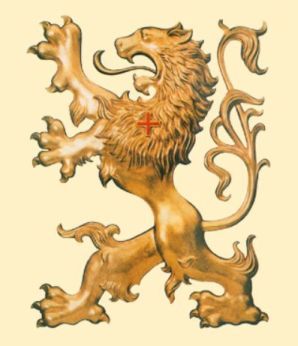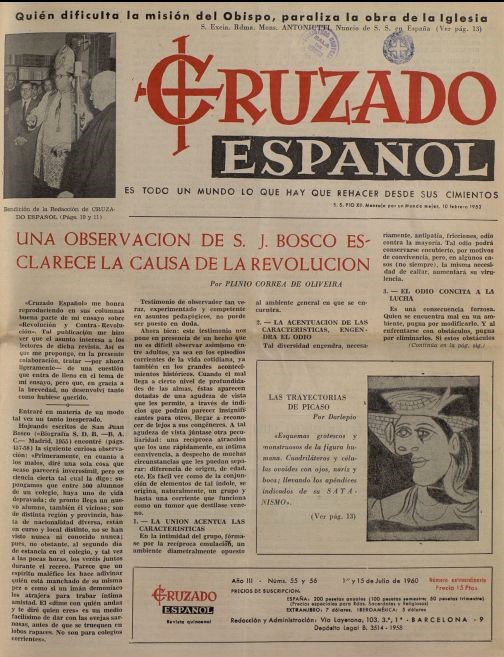|
Plinio Corrêa de Oliveira
St. John Bosco’s observation clarifies the cause of the Revolution
El Cruzado Español, Barcelona, Year III, N. 55-56, July 1 & 15th 1960, pages 1, 2 and 3 |
|
|
"Cruzado Español" (Spanish Crusader) has honored me by reprinting a large part of my study “Revolution and Counterrevolution” in their publication. This made me realize how the topic was of interest to their readers. Thus I propose to expound –although briefly- on a topic which is entirely related to the subject of my study, but was not fully developed to my satisfaction due to my fondness for brevity. * * *
I will delve into the topic in a perhaps unexpected fashion. Paging through the writings of St. John Bosco, I found the following telltale observation: "First, in regards to evil people, I will say something which may seem unbelievable but which in fact is really true. Let us suppose that among a group of 500 school children, one is corrupt; then another perverted student arrives; both are from different regions and places, they never knew nor saw each other. Despite all this, on the second day of school, maybe after a few hours, they are found together during recess. An evil spirit seems to make them guess who else is stained by their same type of darkness, or it is as if a diabolic magnet pulls them together to create an intimate friendship. The saying “tell me who your friends are and I will tell you who you are” is a simple means to single out sheep with skin disease, before they turn into voracious wolves. They are not for regular schools” (Biografia S.D.B. - B.A.C. - Madri, 1955 - págs. 457/58) The testimony of such a true observer, experienced and competent in the field of pedagogy, can not be questioned. Nevertheless, this statement presents an easily recognizable fact before us, even among adults, found in the routine episodes of every day life as well as in the great events of history. When evil reaches a certain level of profundity in souls, these acquire a sharp perception which permits them, by means of symptoms seemingly insignificant to some, to pick out their alike from afar. Such sharpened perception is interwoven with another peculiarity: a mutual attraction that quickly unites them in close friendship, despite the numerous circumstances that may separate them, such as different birthplaces, age, etc. It is easy to substantiate how the association of elements of this nature, naturally give origin to a group or even a trend that operates like a tumor, distilling poison. 1. Union accentuates their characteristics – In the intimacy of the “click”, through reciprocal emulation, an ambience is formed in diametric opposition to the ambience in which they find themselves. 2. Accentuated characteristics engender hatred – Such diversity necessarily engenders antipathies, frictions, and hatred against the majority. This hatred may remain hidden for motives of shared quarters, but in some cases (not always) the need to remain silent itself magnifies their festering anger. 3. Hatred leads to a fight – It is an inevitable consequence. He who feels uneasy in a particular ambience, struggles to change it. And, upon stumbling into obstacles, struggles to eliminate them. If these obstacles do not give way passively, a fight breaks out. 4. The fight leads to proselytism and combined effort – It is natural that a nucleus of evil not only attracts its alike by magnetic force so clarified by St. John Bosco. But it is also natural that by the tendency of expansion inherent in everything that is intensely alive, such as the military’s need of recruiting soldiers for combat, it endeavors to increase the number of its followers. The combined effort originates from a natural necessity, which does not require any explanation. 5. Organization comes forth from such articulation – This is also obvious. Elements permanently connected to each other through a profound affinity of mentality, identity of objectives and an intimate association of efforts, will soon elaborate an ideological system, a program and a common technique of action and build a leadership group. Then, the route is traced between the simple fact that a few “evil ones” exist who reciprocally intuit each other and get in touch, and the formation of an organization. Occult as Masonry, semi-occult as Jansenism or Modernism, declared as Lutheranism or Communism, this organization proposes to fight in all fields – ideological, artistic, social, political, economical, etc. – in conquest of its goals. In a word, it performs Revolution. The hatred against the good The matrix cause of this whole succession of events is the hatred toward good, engendered when perversion reaches a certain level of profundity. I insist on this assertion. I know that when perversion reaches such a level of profundity, it awakens a mysterious capacity of detection and of mutual attraction, described by St. John Bosco, and which constitutes the starting point of all organized revolution. A large number of people sympathize with the good; if they commit any sin, they do so with shame and sadness. If they do not fall morally too low, they need not cause fear as authors of machination. The others’ perversion profoundly attacks humility, to the point of producing a cynical indifference in face of sin, and even rebellion against the good and goodness. Do not tell me that rational beings are incapable of hating goodness. It would be opportune to recall the “distingos” (nuances) the topic requires. Let us briefly remember that if this were simply true, the bad angels would not have hated God, who is Infinite Goodness. Moreover, such aversion may plainly consist of an antipathy. Would it then engender misunderstandings, frictions, and incidents, without generating a machination or a fight, when cases exist that demonstrate a much more aggressive state of spirit? In that sense, the hatred of Cain against Abel seem characteristic to me. Ever more so is the case of the Sanhedrin against Our Lord. Turning from this sublime fact to a contemporary fact, I remember an article I recently read. In the United States a group of playgirls attacked a young schoolmate, reducing her to a deplorable physical state. Interrogated by the police, the delinquents declared not to have any personal charge against their victim. The only reason for their aggressive attitude was that that schoolmate was so exemplar in her studies, in her behavior and in her dress, that the mere fact of her existence made the life of her aggressors unbearable. If we imagine such a state of vitality, not enraged without intelligence or serenity, but in balanced, tenacious and pondered people, we would uncover the origin of a dynamic and dangerous organization, which could bring the end of a historic era. Almost all of these considerations are well known, at least when individually analyzed. But, generally, they come to mind confused and isolated. Exposed and assembled within a frame of doctrine and observation, under the form of common and related traits, we catch a glimpse something new. I will demonstrate, in a few words, what this something consists of. The sympathy and sociability of the moderates Up to this point, we have seen two aspects of evil exposed. One engenders the Revolution. In face of the Revolutionary phenomenon, what does the other bring about? By the same principle of attraction evil has for evil (simile simili gaudet), which is the profound explanation of the phenomenon so keenly observed by St. John Bosco, one gathers that the more subtle evil becomes attracted, hypnotized and dominated by the more intense. It is thus explained how the moderate currents of the Revolution never seriously or lastingly fight against the extremist currents. The Girondists of the XVIII century, the English partisans of parliamentary monarchy of the XIX century, the partisans of Kerensky in the XX century, when brought face to face with the Revolution, always ended up giving in, even when they fought against it with arms in hand with temporary sucess. In this manner, the French bourgeoisie defeated the commune of Paris, and, in appearance, set a dam against the Revolution. But, on assuming command, that same bourgeoisie favored the development of the revolutionary process. There is more. Placed before the Revolution and the Counterrevolution, moderates waver, generally attempting to plead for absurd reconciliation. But, finally, they systematically favor the first against the second. How can this be explained, when so often the highest and most obvious economic interest, the most honorable rank, the deepest traditional education, the closest motives of kinship and the most tender friendship, should persuade the “moderates” to ally themselves with the Counterrevolution? How many gifted men, in the ranks of the “moderates”, had all the intellectual means available to see how their perpetual capitulation was dragging them toward the abyss, all their descendents with them, and nevertheless systematically continued giving in as if this very abyss fatally fascinated them? To answer this question is to explain the most essential cause of the extremists’ systematic victories, in the revolutionary processes, because these always were, or almost always, very few, not very brilliant or of meager financial means. Their victories, in most cases, were due to timidity, blindness, the weakness and resignation of the “moderates”; generally rich, influential, abundant and, invariably disposed to prefer anything but to seriously support the forces of the Counterrevolution, in general also very few, poor, etc. Without any doubt, inertia and fear are the characteristics of the rich class and in part explain this phenomenon. For us, however, it does not explain everything. Because, on one hand, not all the rich classes are irresolute and fearful. For example, the European nobility at the time of the Crusades or the Reconquest did not succumb to this defect. Therefore, the decadent elite are those who suffer of this illness. Antipathy in relation to the Counterrevolution But the fear of the decadent elite does not explain everything. It is notorious how, on one hand they reveal fear of revolutionary extremism, yet on the other emit fleeting and involuntary ideas of sympathy in relation to the mentioned extremism. On the other hand, they do not manifest fear in relation to the counterrevolutionary radicalism, but rather systematic antipathy and hidden evil. Moreover, this sympathy and antipathy, so stable and impulsive, must necessarily play a role, which would be a mistake to underestimate when considering the attitude of the “moderate” revolutionaries. With this laid out, how is this sympathy explained? What does it obey? The “moderates”, apparently so attached to money, health and the pleasures of the revolutionary spirit, only fear a few infections. Can they be, in this case, self-abnegated idealists (in the bad sense of the word, obviously)? In appearance no would be the answer. But the facts, well observed, demonstrate that in a certain measure they are, and that their “idealism” plays a profound role in their psychology and behavior. In what way? The revolutionary spirit constitutes a grave deformation of doctrine and morals. Even though, many times, this coexists together with uncontaminated customs and an unquestionable honesty in business. St. Pious X, in His Encyclical “Pascendi”, pointed this out in reference to the modernists. Whoever has this spirit, even so if by participation, is incorporated in the mysterious dynamism of evil described by St. John Bosco. If the revolutionary spirit in its moderate form does not bring about that capacity of mutual relationship and of dynamic articulation, it produces an analogous phenomenon, but much more frail. This phenomenon is a profound antipathy, at times discreet and subtle, against everything that is opposed to the Revolution. Such antipathy has a peculiar trait. It can almost never be fooled, and it discerns, rejects, and is even hostile to any manifestation of counterrevolutionary spirit, however subtle or veiled. That is why, without reaching the point of taking the initiative to sacrifice their interests in favor of the Revolution, they accept the sacrifice without complaint and perhaps are even consoled by the simple fact that their profound antipathy toward the Counterrevolution is satisfied with the progress of the Revolution. The fact is dreadful. And it would be unbelievable, had it not been clear to the eyes of the whole world. How many bourgeoisie or aristocratic houses are there, destroyed by the Revolution, that renounced any fight and are almost happily resigned within an obscure or almost proletariat situation, perfectly integrated into to revolutionary world of which they are victims. Writing this, countless exiled Russians come to mind, and schismatic clerics in particular, who only worry about reaching an agreement with communism. Discouragement? In part, yes. But discouragement without resentment, almost happy, in which one clearly sees the smile of discreet , perhaps even subconscious, sympathy. One can deduce from this how interests are not what govern history. It is not primarily a conflict of interests, but of principles, a fight between Truth and error, between Good and evil, between Light and darkness The role of the devil What is the role of the devil in this fight? Or at least its action in the phenomenon described by St. John Bosco? In the cited text the Saint clearly admits preternatural action as plausible. On our part, we are persuaded that it is immense. But this aspect of the topic does not fall within the scope of this article, in which we wanted to briefly outline the psychological traits of the natural order, which operate independently, but over which the devil may have influence, frequently with terribly efficacious results in order to make men instruments and victims of the Revolution. The devil was the first author and continues to be the principal factor of the Revolution. |
|


